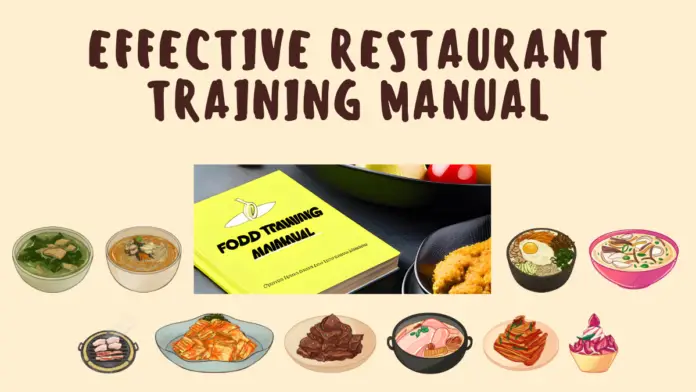In the ever-evolving landscape of the food and beverage industry, equipping employees with the right skills and knowledge is more important than ever. Business owners and managers need to adapt their training methods to cater to the modern demands and expectations of both their workforce and customers. This article will delve into the evolution of employee training in the industry, assess the current training needs, discuss the crafting of an effective restaurant training manual, emphasize the importance of customer service and upselling training, and underline the value of continuous learning and professional development opportunities within the business.
The Evolution of Employee Training in the Food & Beverage Industry
Over the years, the food and beverage industry has seen a significant evolution in employee training. Traditionally, these training were largely focused on in-person, hands-on skill acquisition, and they often lacked a structured approach. It was common for new employees to learn on the job by observing and mimicking their more experienced colleagues. This method, while somewhat effective, often led to inconsistencies in service delivery.
However, the advent of technology and the increasing demand for exceptional customer service has greatly changed this dynamic. Businesses began to recognize the importance of a standardized and systematic approach to training, leading to the development of formal training programs. These programs typically consisted of classroom-style sessions coupled with on-the-job training to ensure a comprehensive understanding of the job.
The rise of the digital age further revolutionized employee training in the industry. Online learning platforms and digital tools are now employed to deliver interactive training modules that are both engaging and flexible. These platforms allow employees to learn at their own pace and even offer performance-tracking features to monitor progress.
With the global pandemic, remote training has gained more traction. It has become a necessity due to social distancing protocols, leading to a surge in the use of video conferencing tools and virtual reality for training. These changes have helped to ensure business continuity and maintain service quality even amidst the crisis.
Today, employee training in the food and beverage industry is a blend of traditional and modern methods. Businesses strive to offer a balanced approach, combining hands-on training with digital learning, to equip employees with the skills needed to excel in their roles and meet the expectations of a sophisticated customer base.
Assessing the Training Needs of the Modern Food & Beverage Business
The first step in creating an effective training program for your food and beverage business is conducting a thorough needs assessment. It is crucial to understand the skills that your employees need to possess in order to perform their tasks effectively and deliver the level of service that your customers expect.
As a business owner, you should identify the roles within your organization and define the core competencies for each role. For instance, kitchen staff would need to be proficient in food preparation and hygiene standards, while wait staff should excel in customer service and product knowledge.
In addition to role-specific skills, it is also necessary to assess the need for training in areas that are universally applicable to all employees. These could include training in safety protocols, team communication, and cultural sensitivity. Understanding the individual and collective needs of your employees can help you design a training program that addresses all relevant areas.
In a world that is increasingly digital, it’s also important to consider the need for technology training. This includes using POS systems, handling online orders, and navigating digital menu boards. In the wake of the pandemic, many businesses have moved towards online ordering and contactless service, increasing the need for employees to be adept in these areas.
Consider the dynamic nature of the food and beverage industry. Trends are constantly changing, and consumer tastes are always evolving. Training programs should be adaptable, and there should be provisions for regular updates to accommodate new developments in the industry.
Here are some things to keep in mind when evaluating the training needs of your food & beverage business:
- Define the core competencies for each role within your organization.
- Understand the individual and collective training needs of your employees.
- Assess the need for universal training in areas such as safety protocols, team communication, and cultural sensitivity.
- Consider the need for technology training as the industry continues to digitize.
- Ensure that your training program is adaptable and can be updated regularly to reflect industry trends and changes.
Crafting an Effective Restaurant Training Manual for New and Existing Employees
An effective training manual is a cornerstone of any successful food and beverage business. It serves as a comprehensive guide for employees, helping them understand their roles and responsibilities, the organization’s standards and expectations, and the correct procedures for their tasks.
According to Synergy Suite, one of the restaurant training resources available to business owners, “Your restaurant training manual is absolutely vital to the long-term success of your employees and your organization.”
The first step in crafting a training manual is to outline the different sections that will be included. Typically, a restaurant training manual should cover topics such as company culture and values, job descriptions, operational procedures, health and safety guidelines, customer service standards, and procedures for handling difficult situations.
The content of the manual should be clear, concise, and easy to understand. Use simple language, include relevant visuals, and avoid industry jargon as much as possible. The aim is to make the manual accessible to all employees, regardless of their level of experience or knowledge.
In addition to written instructions, consider incorporating interactive elements into your training manual. This could include video tutorials, quizzes, and interactive diagrams. Not only does this make the manual more engaging, but it also caters to different learning styles.
The manual should also provide guidelines on how to handle challenging situations that may arise in the workplace. This could range from dealing with customer complaints to handling food allergies. By providing clear instructions on how to navigate these scenarios, you can ensure that your employees feel prepared and confident in their roles.
It’s crucial that your training manual is regularly updated to reflect changes in company policies, industry standards, and customer expectations. This ensures that your employees are always equipped with the most current and relevant information.
While the manual is a vital resource, it should not be the sole method of training. It should be complemented by hands-on training, role-playing exercises, and regular feedback sessions to provide a holistic learning experience.
The Importance of Customer Service and Upselling Training for Staff
Customer service is at the heart of the food and beverage industry. It’s the difference between a one-time customer and a loyal patron who not only returns but also recommends your business to others. Therefore, investing in customer service training for your staff is paramount.
Effective customer service training should equip your staff with the skills to handle various types of customers and situations. This includes understanding and anticipating customer needs, communicating effectively, and resolving complaints satisfactorily. Role-playing exercises can be a great way to simulate real-life scenarios and help employees gain practical experience.
Upselling is another important aspect of customer service training. Upselling involves suggesting additional or higher-value items to customers, thereby increasing the average transaction value. Employees should be trained in the art of subtle and effective upselling – this includes understanding the menu thoroughly, identifying opportunities for upselling, and knowing how to suggest additional items without appearing pushy.
In addition to improving sales, effective upselling can also enhance the customer experience. When done right, it can help customers discover new favorites, complement their meals, and feel more satisfied with their dining experience.
It’s also worth noting that customer service and upselling techniques can differ depending on the type of customer or the time of day. For example, the approach for upselling to a group of friends during a dinner service may differ from that of a business lunch. Training programs should account for these variations and provide staff with the flexibility to adapt their approach accordingly.
Continuous training and reinforcement are vital for maintaining high customer service standards. Regular feedback sessions and refresher courses can help to keep these skills sharp and ensure that your staff consistently delivers exceptional service.
Continuous Learning and Professional Development Opportunities Within Your Business
One of the most powerful ways to engage and retain your employees in the food and beverage industry is by fostering a culture of continuous learning and professional development. This not only benefits your business by enhancing the skills and knowledge of your workforce, but it also helps to keep your employees motivated and invested in their roles.
Incorporating continuous learning into your business can take various forms. This could range from regular training sessions and workshops to online courses and industry seminars. You can also offer role-specific training to help employees advance in their careers, such as leadership training for those aiming for managerial roles.
Professional development opportunities could include mentoring programs, where less experienced staff are paired with seasoned employees to learn from their expertise. These programs can help to build strong relationships within your team and promote a collaborative learning environment.
Creating a pathway for career progression is another effective way to encourage professional development. Clearly defined career paths can give employees a sense of direction and motivation to upskill. Show your employees the potential for growth within your business and provide the necessary training and support to help them reach their career goals.
Recognition is a powerful tool for promoting professional development. Recognize and reward employees who show initiative in their learning and development. This could be in the form of verbal recognition, certificates, or even incentives such as bonuses or promotions.
Remember to incorporate feedback into your continuous learning initiatives. Regular feedback can help your employees understand their strengths and areas for improvement. It can also provide valuable insights into the effectiveness of your training programs and highlight any areas that need attention.
A robust and adaptive training program is an essential ingredient for success in the modern food and beverage business. By acknowledging the evolution of training methods in the industry, assessing the specific training needs of your business, crafting an effective training manual, focusing on customer service and upselling skills, and promoting continuous learning and professional development, you can create a workforce that is well-equipped to meet the demands of the industry and provide an exceptional customer experience. In doing so, you not only strengthen your business’s foundation but also foster a positive and engaging environment that empowers your employees and motivates them to excel.


The content Team Writer is one of the writers from our team of content writers. The Business Goals blog is expanding day by day and we need more writers and brand ambassadors for promoting our media website. If you are interested contact your portfolio through the Write for Us page.
















































